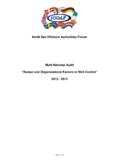Transcription of Revealing Strategies for Operation, Maintenance …
1 Technip Stone & Webster Process Technology, a world-class downstream technology leader Poornima Sharma/ Jean-Paul Laugier Oct 30, 2013 Revealing Strategies for Operation, Maintenance and Procurement to fully Evaluate Petrochemical Industry to Support Production Capacity Perspective of an EPC Contractor- Resourcing- Labor & Equipment 1 Table of Contents Overview - US Ethylene Market/Projects Major Project Risks Strategies to Mitigate Risks Highlighting execution processes to reduce engineering resources Examining Strategies to meet procurement requirements for specialist equipment Role of Modularization to manage Construction Risks Conclusions 2 Overview- Ethylene Market/ Projects 3 Unprecedented number of mega Oil & Gas projects in the US Since Q4 2011, approx.
2 10 MTA ethylene projects have been awarded, mostly as new grass root plants There are initial indications for a second wave of grassroots ethylene plants in the US Major revamps of existing Ethylene units are also under consideration, to use Shale derived Ethane There are other projects in the US driven by Shale Gas- o Monetization of natural gas (conversion of LNG import to export terminals), o PDH units for propylene production to replace propylene lost from naphtha crackers, o GTL projects in the planning phase 4 Significant Competition for engineering, construction and fabrication resources in the US Major Ethylene Capacity Addition in the US 5 In the past, North America was a net exporter of Ethylene.
3 In the recent years the ethylene market within North America was balanced between import and export By 2017, 30% additional ethylene production will be added to the US market. Large export of ethylene and derivatives will likely be needed Statistics- World Scale Gas based Ethylene Cracker Typical capacity for USGC- 1500 kta Ethylene Estimated investment for ISBL unit- $ $ bn Plot Size-960 ft X 930 ft (85000- 100,000 sq. mt) Home office man-hours: 800,000- 1,000,000 Structural steel 6,500 to 10,000 tons Underground pipe 40,000 ft to 55,000 ln ft Above ground pipe 650,000 to 750,000 ln ft Average dia of to in Electrical power cable 300 km to 400 km Instruments (ea) 9,000 to 11,000 6 Peak Construction Taskforce: 3000 persons Typical Timeline: USGC Grass roots Ethylene Project Grass roots units PDP- 4-6 months FEED phases- Approx.
4 8-10 months Detailed Engineering & Procurement 24 months , Construction- 30 months Overall EPC phase: 40-44 months Plant Expansions & Feed Flexibility Projects Overall schedule: EPC phase: 24-36 months Implementation is dependant on Turn-Around schedule Modifications rather than replacement of existing equipment, specially compressors, helps with the shorter schedules 7 Ethylene from plant expansion likely available to the market earlier than from grass roots units Project Risks- US Ethylene Projects 8 Project Risks- Grass roots Ethylene in USGC Risks Schedule Delay and Cost Over Runs resulting from: Insufficient experienced resources with EPC contractors in the US to cover multiple projects delay in design development Delays in design delays Permit -application and grant- unable to begin construction Lack of shop space with fabricators again due to multiple world scale projects Shortage of skilled labor for construction resulting in increase in wage rates.
5 Drop in productivity during construction phase Plant Performance and Reliability below expectation 9 Strategy needed to ensure Certainty of Outcome- Schedule /Costs/Reliability Strategies to Mitigate Risks- EPC Contractor s perspective 10 Strategies to Mitigate Risks Manage Schedule and Cost: Use Reference Cracker design Simplify engineering and procurement process Significantly Shorten PDP/FEED phase- leverage availability of technical data/knowledge Support permitting through ready technical data from Reference Cracker Place orders for Long Lead Equipment in FEED phase to tie down shop space, vendor costs Use Reference Cracker design to shorten cycle for issuing data sheets and requisitions, early placement of orders Use MTOs from Reference Cracker design- Certainty of quantities Reference Cracker plot layout allows early assessment of Constructability.
6 Planning for resources during construction 11 What is a Reference Cracker Design ? An optimized plant design based on proven technology The reference plant is derived from successful gas cracker designs for the world s three large ethylene units safe, operable proven 1270kta Canadian cracker and 1300 Kta in the Middle East in successful operation & 1500 Kta cracker designed for USGC Incorporates specific requirements for the current USGC projects Incorporates the current USGC permitting requirements Design that conforms to the relevant codes and standards Plant design documentation that is readily available Technical data/knowledge and experience can be leveraged to develop a fast track project 12 Reference Design Cracker T-shape Plot Layout Reference Cracking Furnace 14 Standard Design of Cracking Furnace Enables early procurement of long lead equipment Provides ready information
7 To plan/simplify erection processes Mechanical completion of all furnaces can be planned to be 2-3 months ahead of mechanical completion of balance of plant Benefits of Reference Cracker design A proven ethylene plant capacity Early confirmation of basic plant configuration to minimize potential changes to process basis of design Equipment sizing leading to better project cost estimates, Allows early procurement for LLIs Equipment arrangement and preliminary plot plan available early Lowers front-end engineering cost Shorter overall project implementation schedule 15 Manage Availability of Home Office Resources Grass roots Ethylene Plant Home Office Services Typical Home Office Manhours- 800,000- 1,000,000 Peak Staffing in the range of 350 Manage Engineering and Procurement Resources : Leverage Engineering resources in multiple centers and share work.
8 Maximize use of High Value Engineering Centers outside US Technip has Ethylene Plant Design resources in: Houston and Los Angeles in the US Paris and Rome in Europe Chennai, Delhi and Mumbai in India As an example: 200 Ethylene Process Design Engineers Experts available worldwide in Technip. 100 out of these are in the US 16 Early Procurement for Long Lead Equipment Equipment Delivery Cracked Gas Compressor 20-24 months Refrigeration Compressor 18-22 months Expander 16-20 months Large Pumps 14-18 months Quench Water Pumps VHP BFW Pumps Cold Box 12-16 months C2 Splitter 16 months Quench Column 12 months Reactors 14 months 17 Maximize placement of orders for LLE during FEED and lock-in shop space and delivery schedule Typical Delivery times.
9 Long lead items- Impact on Design & Construction Compressors and associated turbines and expanders Compressors (CGC, C3R, C2R) and expander are longest lead equipment (18 to 24 months) These equipment are the most critical in overall design activities (piping, building) and operation stand point Limited number of suppliers: Overloading of the workshop is a major issue in case of numerous ethylene projects Early procurement activity feasible when using a Reference Design Large towers Very large towers (C2 splitter/C3 splitter) are the second long lead equipment Large towers required specific logistic for transportation Large towers required specific lifting which might delays other construction activities (HSE) 18 Long lead items- Impact on Design & Construction Cracking furnaces components require early procurement Radiant coils and TLE s : Few suppliers Convection section generally supplied as modules to simplify construction activities.
10 Multiple components- Alloy/SS/CS tubes, tube sheets, alloy intermediate tube sheets, finning - All required to be delivered to module fabricators Early design activities needed to satisfy environmental permitting needs Using reference furnace designs can help minimize risk of delay in placement of orders 19 Construction phase Projects Schedule is mostly driven by construction Early definition of the mobilization for the construction using benchmark design for quantities Accurate MTO s and the corresponding delivery on site to confirm mobilization Investigate modularization of part of the plant to minimize work on site and therefore minimize risks due to mobilization of labor on site 20 Examples of Modularization- Cracking



